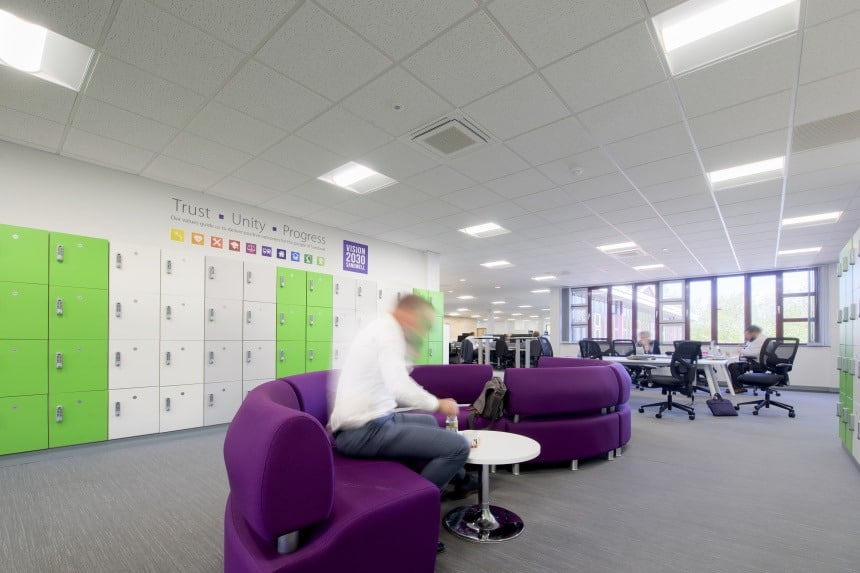
NABERS UK: Could a new building energy efficiency rating be the ‘next big thing’ to drive LED upgrade opportunities in the contracting market?
NABERS UK is the latest energy efficiency rating system to take the built environment – and specifically, commercial office buildings - by storm. Its particular focus on building performance sets it apart from other rating systems. Tamlite Lighting, one of the UK’s leading independent lighting manufacturers believes it is an area the electrical supply chain needs to keep an eye on. Colin Lawson, Head of Sales and Marketing at Tamlite, explains why.
Administered by buildings research and standards body BRE, NABERS UK hit the headlines following its launch in November 2020. If you have never heard of it, it is no surprise. Three years later and NABERS remains one of the newest rating systems in the built environment sector. Similar to the efficiency stars that label household items such as refrigerators and washing machines, it utilises a 6-star system to measure and rate the actual energy use of commercial buildings.
Unlike other schemes, NABERS UK rates the actual energy performance of commercial offices based on metered energy consumption. Once certified, NABERS ratings are valid for 12 months. This time frame ensures that ratings are accurate to the building’s current operational performance and helps to identify areas for savings and improvements.
Providing annual ratings measurements also means building owners can benchmark the progress of their building’s year-on-year change of operational energy consumption, as well as identify progress compared to other buildings participating in the ratings scheme.

‘Opportunity for electrical contractors’
At Tamlite, we believe NABERS UK will drive new opportunities for energy efficiency focused projects in the commercial office buildings sector. There has been a notable spike in interest in this rating system from both consulting engineers and end customers. Ultimately, this will translate into a rise in energy efficiency led projects. It’s a topic that contractors should be aware of.
A lack of awareness from some quarters may be a result of confusion about how (and where) NABERS UK differs from the BREEAM buildings rating system. The main difference between the two building rating systems is that BREAAM is a design-based energy rating, whereas NABERS UK measures and rates the actual energy use of offices, specifically.
While NABERS separates base building ratings from the tenancy and whole building ratings, BREEAM assigns a single rating to the entire building. BREEAM focuses more specifically on sustainability of the built environment through the perspectives of energy, health and wellbeing, land use, materials, innovation, management, and pollution.
Benefits of NABERS UK
We see the NABERS rating system as an important tool for promoting sustainability in the built environment. There is no doubt that it will help building owners and occupants to understand their environmental impact and identify areas for improvement. Whilst NABERS is not yet mandatory here in the UK, it provides a transparent and standardised rating system.
It will also encourage competition among buildings to become more sustainable. More efficient energy consumption also translates to lower energy costs, allowing building and business owners to invest the saved money where it is needed most.
Research in 2021 from real-estate firm Knight Frank[1] found that offices with NABERS Energy ratings of up to 4.5 stars were worth an average of 8% more than unrated buildings on a per square metre basis. This premium jumped up to 18% among offices with five- and six-star ratings.

LED lighting: improving NABERS ratings
The Indoor Environment (IE) rating of NABERS measures the lighting quality, indoor air quality, acoustics, temperature, and thermal comfort of a building. NABERS UK ratings are based on metered energy consumption. Therefore, enhancing energy efficiency of lighting within buildings can greatly impact energy demand, operational costs, and improve NABERS ratings. For more detailed insight, BRE offers useful downloads and a products page.
NABERS UK is likely to cause increased demand for quick-wins on energy efficiency – particularly in light of the phase-out of older technologies, including halogen and fluorescent lamps due in Autumn 2023.
NABERS echoes our own guidance on straight-forward steps that can be taken to improve indoor lighting efficiency and quality. LED lighting offers businesses an easy solution to quick install and a relatively small investment. As contractors know, replacing outdated lighting with modern LED systems, coupled with intelligent control systems, buildings can be made more efficient, generating savings of between 60% to 80%.
For any lighting project and retrofit, request a FREE lighting energy survey from Tamlite - tamlite.co.uk/energysurvey
[1] https://www.knightfrank.com/research/article/2022-04-20-how-can-nabers-sustainability-rating-benefit-occupiers-#:~:text=Knight%20Frank%20research%20for%20the,five%20and%20six%20star%20ratings.